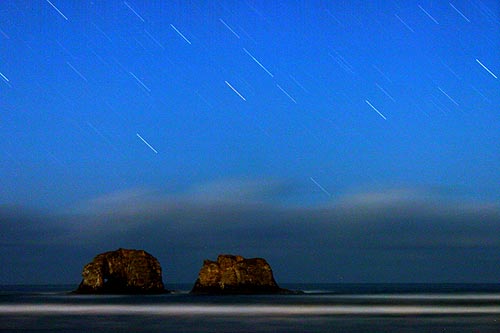Comet Y4 Could Be Bright Spot for Washington, Oregon Coasts - Portland to Seattle
Published 03/31/2020 at 6:44 AM PDT
By Oregon Coast Beach Connection staff

(Portland, Oregon) – Those on the Washington coast and Oregon coast as well as inland places like Seattle, Portland, Eugene and Tacoma may get to see plenty in the skies soon. A comet called Y4 ATLAS (Y4 for short) was discovered on December 28 and it could wind up the brightest thing the Earth and the Pacific Northwest have seen in a long time. That doesn’t neccessarily mean a massive fireball in the sky, nor the slow-moving splendor of Comet Hale-Bopp in the ‘90s. But scientists think it could be visible with the naked eye to some degree and possibly spectacular. (Above: Comet Wirtanen back in December, courtesy NASA. The long streak is from a rocket body passing by).
This discovery and many other comet finds were made by project in Hawaii called ATLAS (Asteroid Terrestrial-impact Last Alert System), which is scanning the skies for asteroids that may someday collide with Earth. Back then, Comet C/2019 Y4 was a feeble object in the skies, barely visible with all their hi-tech gear. However, in March it surged in brightness to a magnitude 8 after being discovered at a magnitude 19.6 (that’s an increase of brightness about four thousand times). Now it’s slowly entering the inner solar system, and while not yet visible to the eye it’s expected to become even brighter soon.
Right now it’s moving through the orbit of Mars, and as it gets closer to the sun it begins to heat up the ice inside, creating a bigger tail and brighter object
According to Astronomy.com, Y4 should be at least visible with binoculars sometime in April. However, comets have a mind of their own, and their twinkle and their tails could simply fizzle suddenly without notice.
On the flip side, it is vaguely possible the comet could be the brightest thing in the skies in generations.
Luckily for Oregon and Washington it’s set to be quite a show for the northern hemisphere. Y4 will makes its closest approach to the sun (called perihelion) on May 31, and for the northern half of the world it will be visible through then. The southern hemisphere only gets one good week out of it starting May 28, according to Astronomy.com.
Scientists say even in cities with light pollution a faint but large halo may be seen. As the atoms of the comet’s tail are ionized by ultraviolet light, it may at first appear gray to human eyes, then moving to a blue. You could even see the tail break away at certain points and then appear to reconnect.
Along the Oregon and Washington coasts, plenty of dark spots should allow for good viewing – if the weather cooperates. Inland Washington and Oregon will have a rougher time in city areas, and given the current restrictions of social distancing finding a good spot just outside of a town could be difficult, even late at night. State parks in both states are closed and off limits, but city parks and green spaces usually are not.
Your best bet may be unpopulated rural side roads just outside of town or expansive green spaces on the outer edges. Check the rules for your area.
Cannon Beach Lodging
Nehalem Bay Lodgings
Manzanita Hotels, Lodging
Three Capes Lodging
Pacific City Hotels, Lodging
Lincoln City Lodging
Depoe Bay Lodging
Newport Lodging
Waldport Lodging
Yachats Lodging
Oregon Coast Vacation Rentals
Oregon Coast Lodging Specials
More About Oregon Coast hotels, lodging.....
More About Oregon Coast Restaurants, Dining.....
LATEST Related Oregon Coast Articles
A curious weather phenomenon that happens more out here
Curb, Road Construction Resumes in Lincoln City as Oregon Coast Season Begins...
Crews return Sept 15 with some dust and small delays. Traffi
NASA Announces First Evidence of Life on Mars in Possible Biosignature
In a former riverbed billions of years old, they found spots with interesting compounds. Astronomy
Portland, Oregon - Beaverton, Oregon Weather and Alerts | Current Conditions,...
Current weather conditions and alerts for Portland and Beaverton
Oregon Coast Scenic Railroad's Fame Engine Turns 100 Years Old with Special Runs
Sept 20 and 21 various special rides. Garibaldi events, Rockaway Beach events, Wheeler events
South Oregon Coast Goes Interstellar: Coos Bay's Sunset Bay Astronomy Fest Se...
Shore Acres State Park gets spacey. Coos Bay events
Swarm of 12 Quakes Fire Off 100 Miles from South Oregon Coast
After the initial 5.8, ranging in magnitude from 2.7 to 5.1: Coos Bay, Port Orford, Bandon, Gold Beach. Geology, weather
SOLVE Cleanup Happens Along Oregon Coast, Inland Sept 20 Through 28
SOLVE is inviting volunteers to take part. Brookings events, Gold Beach events, Port Orford events, Coos Bay events, Bandon events, Florence events, Yachats events, Newport events, Lincoln City events, Rockaway Beach events, Manzanita events, Cannon Beach events, Seaside events, Astoria events
Back to Oregon Coast
Contact Advertise on BeachConnection.net
All Content, unless otherwise attributed, copyright BeachConnection.net Unauthorized use or publication is not permitted



















































